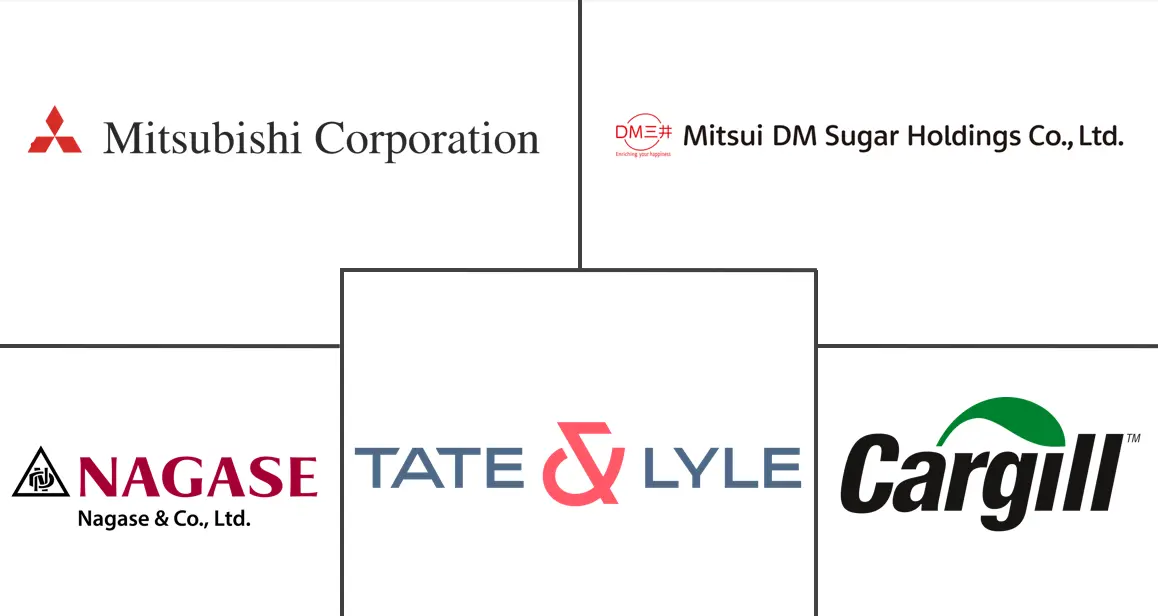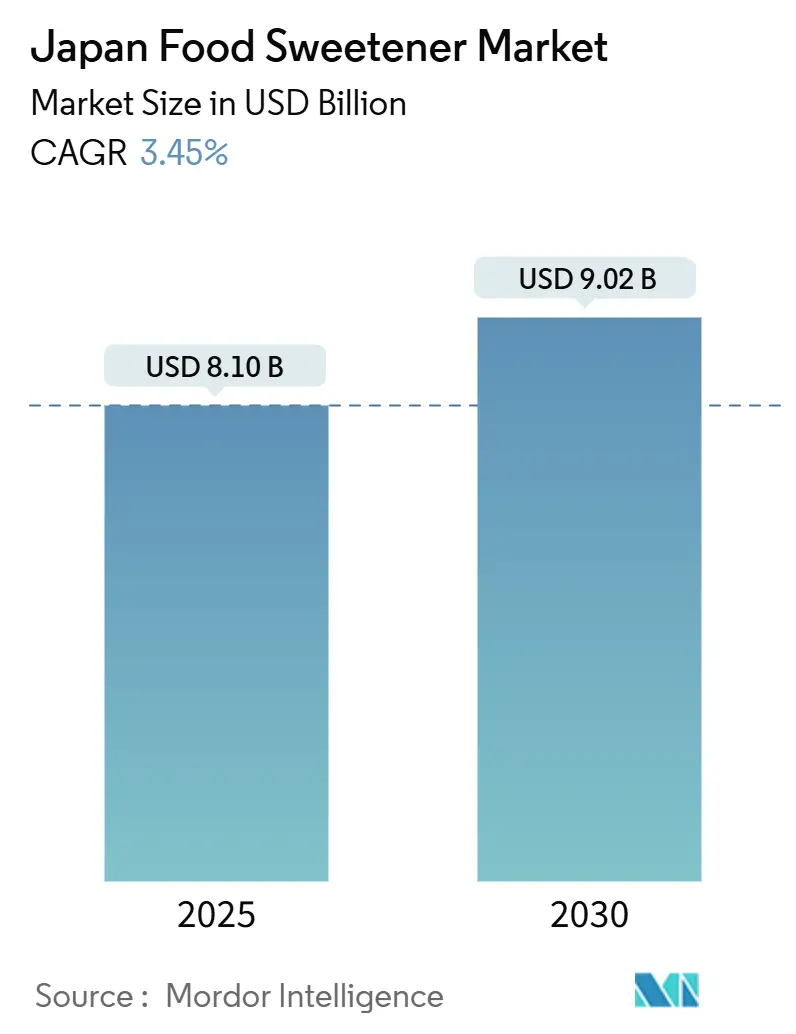
Japan Food Sweetener Market Analysis by Mordor Intelligence
The Japan food sweeteners market size stands at USD 8.10 billion in 2025 and is forecast to reach USD 9.02 billion by 2030, expanding at a 3.45% CAGR. This growth reflects demographic aging, rising diabetes prevalence, and strong regulatory oversight that together reshape consumer and manufacturer behavior. Sucrose remains the largest product category, yet reformulation pressure is steering beverage, dairy, and dessert brands toward high-intensity and plant-based alternatives. Manufacturers rely on domestic research and development capabilities to improve extraction yields and flavor profiles, while strict additive approvals sustain entry barriers that favor incumbents. Export-oriented processors also adopt advanced enzymatic and fermentation technologies to meet foreign labeling norms, reinforcing Japan’s role as a premium ingredient innovator. The Japan food sweeteners market continues to balance cost competitiveness with health-driven differentiation, giving natural solutions a measurable edge.
Key Report Takeaways
- By product type, sucrose led with 43.26% of the Japanese food sweeteners market share in 2024; high-intensity sweeteners are projected to post the fastest 5.42% CAGR through 2030.
- By source, artificial sweeteners accounted for a 42.67% share of the Japanese food sweeteners market size in 2024, while plant-based alternatives are set to expand at a 4.62% CAGR to 2030.
- By application, beverages held 38.58% of the Japanese food sweeteners market in 2024; dairy and desserts are advancing at a 4.58% CAGR through 2030.
Japan Food Sweetener Market Trends and Insights
Drivers Impact Analysis
| Drivers | (~)% Impact on CAGR Forecast | Geographic Relevance | Impact Timeline |
|---|---|---|---|
| Rising Demand for Low-Calorie Sweeteners | +1.2% | National, concentrated in urban centers | Medium term (2-4 years) |
| Expansion of processed food and beverage manufacturing | +0.8% | National, with manufacturing hubs in Kanto and Kansai | Long term (≥ 4 years) |
| Rising Demand for Clean-Label Formulations | +0.7% | National, led by premium retail channels | Medium term (2-4 years) |
| Technological Advancements in Extraction and Processing | +0.5% | National, centered on research and development facilities | Long term (≥ 4 years) |
| Strong regulatory support for the use of Natural Sweeteners | +0.3% | National regulatory framework | Short term (≤ 2 years) |
| Market growth fueled by imports of specialty and fermentation-derived sweeteners. | +0.5% | National, with increasing global reach | Short term (≤ 2 years) |
| Source: Mordor Intelligence | |||
Rising Demand for Low-Calorie Sweeteners
With Japan's aging population and growing health awareness, the demand for low-calorie sweeteners is rapidly increasing. The National Institute of Health and Nutrition's Health Japan 21 initiative seeks to reduce obesity rates among males aged 20-60 from 31.2% to 28% by 2025, driving the adoption of sugar alternatives[1]Source: National Institute of Health and Nutrition, “Health Japan 21 Analysis and Assessment Project,” nibn.go.jp. Consumer surveys indicate that 73% of Japanese adults now prefer zero-sugar or low-sugar products. This preference extends beyond beverages to confectionery, where major retailers have reported a remarkable 209% growth in zero-sugar products, while traditional sugary options have declined by 9%. Japan's Gen Z demographic is particularly embracing this trend, with SHIBUYA109 lab surveys showing a strong preference for "no-guilt" desserts made with natural sweeteners. Additionally, regulatory support from the Foods for Specified Health Use (FOSHU) system validates the use of low-calorie sweeteners in functional food categories.
Expansion of Processed Food and Beverage Manufacturing
Japan's processed food market is experiencing significant growth, driving increased demand for a wide range of sweetening solutions as manufacturers adapt their products to align with shifting consumer preferences. The ready-to-drink (RTD) tea segment serves as a prominent example of this trend, with the emphasis on convenience encouraging the incorporation of sweeteners into new product categories. According to Cross Marketing's 2024 consumer survey, polyethylene terephthalate (PET) bottle formats are the most preferred packaging option due to their "easy to drink" features and resealability, which favor pre-sweetened formulations over consumer-added sugar. Substantial investments by major food processors, such as Nisshin OilliO's "Value UpX" business plan, which extends through the fiscal year 2028 (FY2028), underscore ongoing capacity expansion efforts. This growth particularly benefits high-intensity sweeteners, which deliver cost efficiencies in large-scale production while maintaining flavor consistency across a variety of applications. Additionally, Japan's strategic role as a regional export hub for processed foods further strengthens this trend, as manufacturers seek sweetening solutions that meet both domestic consumer preferences and international regulatory standards.
Rising Demand for Clean-Label Formulations
In Japan, the growing preference for clean-label products is transforming the sweetener market, fueled by increasing skepticism toward artificial additives. To address this shift, Japan's Consumer Affairs Agency has banned the use of the terms "artificial" and "synthetic" on food labels. This regulatory change significantly benefits plant-based sweeteners, with stevia and monk fruit gaining popularity in premium product segments. The clean-label movement extends beyond individual preferences, influencing institutional procurement as well. The Health Japan 21 initiative aims to increase the number of registered corporations providing low-salt and low-fat products from 14 in 2012 to 100 by 2025, according to the National Institute of Health and Nutrition. Manufacturers are adopting precision fermentation technologies to scale the production of "natural" sweeteners. For example, Tate & Lyle has partnered with Manus Bio to produce stevia Reb M through bioconversion, ensuring compliance with clean-label standards. This trend is particularly evident in the confectionery sector, where health-conscious consumers are driving the reformulation of traditional sugar-heavy products to balance indulgence with healthier choices.
Strong Regulatory Support for the Use of Natural Sweeteners
Japan is enhancing its regulatory framework to promote the adoption of natural sweeteners. The Ministry of Health, Labour and Welfare (MHLW) has implemented a positive list system for food additives, streamlining the approval process for natural sweeteners while maintaining stringent safety standards. This system pre-approves specific additives, thereby reducing the time and complexity required for approval, which is particularly beneficial for manufacturers aiming to introduce innovative products to the market. Furthermore, the Foods with Function Claims (FFC) system, which is designed to facilitate the commercialization of functional food products, supports this initiative by enabling eligible natural sweeteners to complete the notification process within a timeframe of 5.5 to 9.5 months. This represents a significant improvement compared to the traditional approval timeline for food additives. The FFC system provides a structured and transparent approach for manufacturers to scientifically validate and communicate the functional benefits of their products, thereby fostering innovation and encouraging competition in the natural sweeteners market. Japan's efforts to align its regulatory framework with international standards are evident through its active participation in global standards development initiatives. This commitment was highlighted at the International Food Ingredients and Additives/Health Food Exposition and Conference Japan (IFIA/HFE JAPAN) 2024 exhibition, which placed a strong emphasis on the Foods with Function Claims guidelines [2]Source: ifia/HFE JAPAN, “ifia/HFE JAPAN 2024 Show Report,” ifiajapan.com. The regulatory environment in Japan is particularly advantageous for stevia-based products, with the Japan Stevia Association playing a pivotal role in developing industry standards and offering clear guidance to manufacturers. In contrast, synthetic alternatives face more complex and time-consuming approval processes, posing significant challenges for synthetic suppliers and further strengthening the competitive position of natural sweetener providers in Japan's increasingly health-conscious market.
Restraint Impact Analysis
| Restraints | (~)% Impact on CAGR Forecasts | Geographic Relevance | Impact Timeline |
|---|---|---|---|
| Stringent additive approval and labeling rules | -0.9% | National regulatory framework | Long term (≥ 4 years) |
| Consumer skepticism on artificial sweetener safety | -0.6% | National, amplified through social media | Medium term (2-4 years) |
| Growing preference on calorie reduction | -0.4% | National, concentrated in health-conscious segments | Short term (≤ 2 years) |
| Rising type 2 diabetes linked to high sugar consumption | -0.3% | National, with regional variations | Medium term (2-4 years) |
| Source: Mordor Intelligence | |||
Stringent Additive Approval & Labeling Rules
Japan's rigorous food additive regulations create substantial challenges for sweetener manufacturers, prolonging product development timelines and complicating market entry. The Ministry of Health, Labour and Welfare enforces a positive list system that requires extensive safety documentation, often resulting in multi-year approval processes for novel sweeteners, particularly synthetic alternatives. Recent regulatory issues underscore the cautious approach of Japanese authorities. For example, in February 2025, the Consumer Affairs Agency addressed concerns about the Red No. 3 dye, stating "no data" on health risks despite warnings from the FDA. The Food Safety Commission requires comprehensive toxicology studies for risk assessments, a process that can take 3-5 years and cost millions of dollars. These regulatory barriers are especially challenging for international sweetener suppliers aiming to enter Japan's market. They must navigate complex documentation requirements while competing with established domestic players who already have regulatory approval. Additionally, these strict regulations can delay product reformulations. Manufacturers must secure regulatory clearance for new sweetener combinations, limiting their ability to quickly adapt to changing consumer trends.
Consumer Skepticism on Artificial Sweetener Safety
Consumer wariness toward artificial sweeteners is growing, driven by safety concerns amplified through social media and advocacy groups, which is limiting market growth. A February 2025 petition to ban aspartame in Europe, citing IARC's classification of it as "possibly carcinogenic," highlights how global safety debates influence Japanese consumer perceptions, even when domestic regulators approve the product. Activism by organizations such as the Consumers Union of Japan, which opposes genome-edited foods and artificial additives, further intensifies skepticism toward synthetic sweeteners. Incidents like the July 2024 safety concerns over erythritol in weight-loss drinks have further undermined consumer trust in artificial sweeteners. This skepticism is particularly evident in the high-intensity sweetener segment, where products like aspartame and sucralose face increasing resistance despite their advantages in food processing. Consequently, manufacturers are heavily investing in consumer education and transparent labeling while redirecting product development efforts toward natural alternatives. These natural options, while commanding premium prices, offer limited scalability.
Segment Analysis
By Product Type: Sucrose Dominance Faces High-Intensity Challenge
In 2024, traditional sucrose holds a significant 43.26% share of the market, highlighting Japan's strong confectionery traditions and the indispensable role of sugar's functional properties. At the same time, high-intensity sweeteners are experiencing rapid growth, with a projected CAGR of 5.42% through 2030, driven by beverage reformulations and regulatory support for low-calorie alternatives. Starch sweeteners and sugar alcohols maintain a balanced position. Sorbitol, in particular, is gaining prominence in Japan's food-grade market, currently valued at USD 0.20 billion and expected to reach USD 0.30 billion by 2030, reflecting a 4.5% CAGR. Beyond its traditional food uses, sorbitol is establishing itself in pharmaceutical and cosmetic applications. This evolving market underscores Japan's dual structure: traditional applications continue to drive sucrose demand, while health-conscious consumers are fueling the rise of high-intensity sweeteners.
Within the high-intensity sweetener segment, stevia leads as the preferred natural option, while sucralose dominates among synthetic alternatives. JK Sucralose Inc. stands out with its compliance with Japanese standards and a strong global presence. Neotame and Ace-K cater to specialized markets, where their intense sweetness justifies premium pricing, particularly in pharmaceutical formulations designed to mask bitterness. The Food Safety Commission of Japan significantly influences product development, prioritizing natural high-intensity sweeteners with faster approval processes over synthetic options. This regulatory environment provides a competitive advantage to stevia and monk fruit suppliers, positioning them ahead of traditional artificial alternatives.
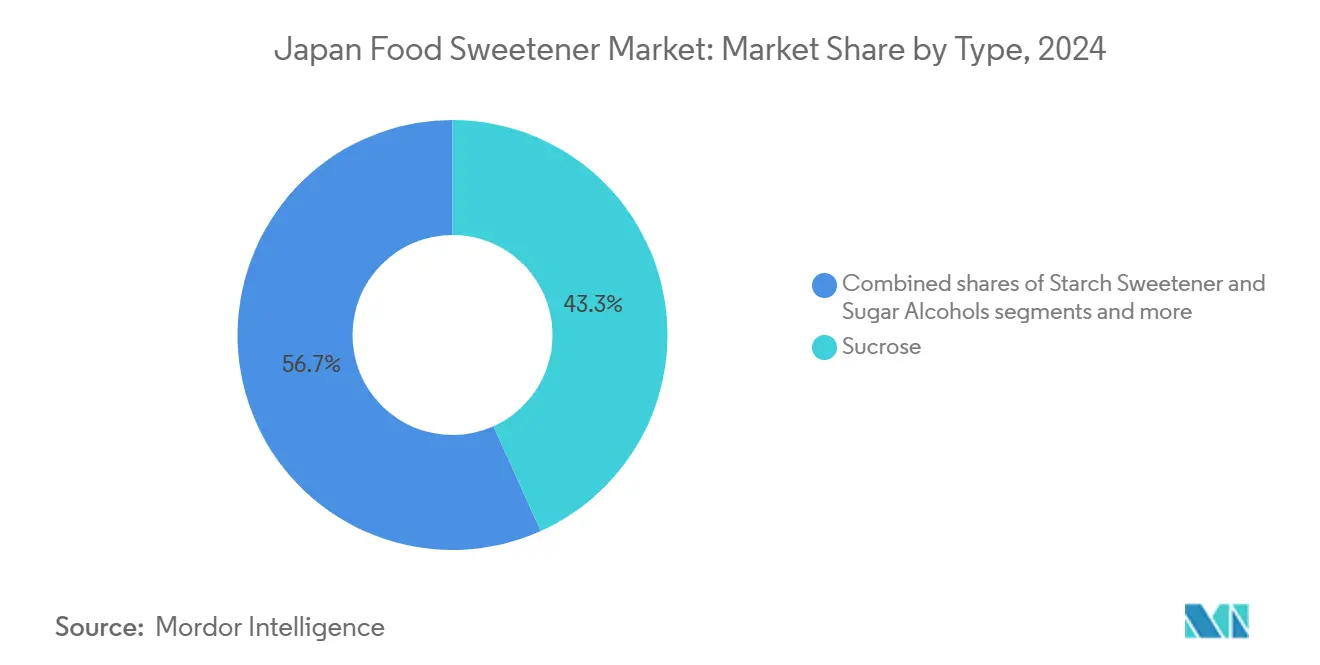
Note: Segment shares of all individual segments available upon report purchase
By Application: Beverages Lead While Dairy Accelerates
In 2024, beverages hold a leading 38.58% share of the market, highlighting Japan's thriving ready-to-drink sector, where convenience and consistent taste significantly influence sweetener choices. Dairy and desserts are experiencing notable growth, with a 4.58% CAGR projected through 2030, driven by health-conscious trends as consumers seek indulgent yet guilt-free options. A 2024 survey by Cross Marketing indicates a strong preference for PET bottle formats, valued for their resealability and portability. This preference supports pre-sweetened formulations, which are favored over consumer-added alternatives. Japan's application landscape reflects a unique combination of on-the-go convenience and high-quality expectations, driving demand for premium sweeteners.
Despite the rise of health trends, confectionery products continue to see stable demand. This stability is attributed to Japan's traditional sweets culture, which still relies on sucrose, even as modern confections increasingly adopt alternative sweeteners. The bakery sector faces reformulation challenges as initiatives like Health Japan 21 promote reduced sugar consumption. However, this shift creates opportunities for sugar alcohols, which help maintain the texture and browning properties essential for baked goods. Additionally, sauces, dressings, and spreads are emerging as key applications. In these categories, sweeteners serve dual purposes, enhancing taste while also contributing to preservation and texture modification. Advances in enzymatic processing technology are enabling the development of customized sweetness profiles tailored to specific culinary applications.
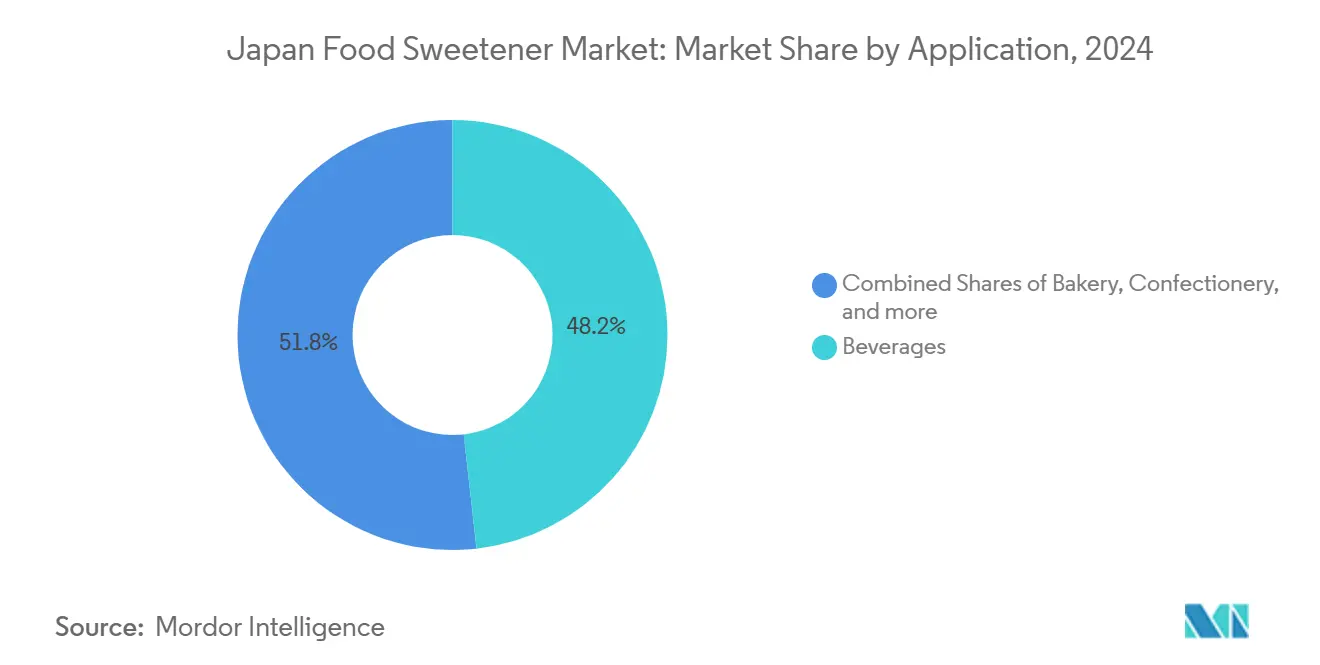
Geography Analysis
Japan's food sweeteners market navigates a complex landscape, balancing domestic production with import dependencies. Major cities like Tokyo, Osaka, and Nagoya serve as the epicenters of sweetener consumption, housing both food processing facilities and a discerning consumer base. While urban centers swiftly embrace alternative sweeteners, rural areas maintain a stronger affinity for traditional sugar. This geographic distribution mirrors Japan's industrial landscape, with leading food manufacturers strategically positioned near port cities for easy access to imported raw materials and proximity to consumers. The use of sweeteners is increasing in various applications such as bakery, beverages, and others due to their popularity. According to the Ministry of Internal Affairs and Communications (Japan) data from 2023, the per capita consumption volume of carbonated drinks was 30.4 liters[3]Source: Ministry of Internal Affairs and Communications (Japan), " Per capita consumption volume of non-alcoholic beverages in Japan", maff.go.jp.
Key players, including Ajinomoto Co., Inc., headquartered in Tokyo, and Matsutani Chemical Industry Co., Ltd., based in Hyogo Prefecture, leverage Japan's advanced biotechnology infrastructure to develop proprietary sweetener technologies that cater to evolving market requirements. Despite the implementation of protective trade policies designed to support domestic industries, Japan faces significant agricultural limitations, including restricted arable land and climatic challenges, which necessitate a heavy reliance on imported raw materials such as raw sugar and corn-based sweeteners. A comprehensive analysis by the United States Department of Agriculture (USDA) underscores Japan's complex tariff structures, which are strategically crafted to encourage domestic production while controlling the flow and pricing of imports. Additionally, the Agriculture and Livestock Industries Corporation (ALIC) enforces a surcharge system that imposes price premiums on imports, thereby providing a competitive edge to domestically produced alternatives, as highlighted by the USDA Economic Research Service.
In a strategic move, Mitsui DM Sugar partnered with Toray Industries in Thailand for cellulosic sugar production, underscoring the trend of Japanese firms broadening their horizons to tap into diverse feedstock sources. This evolving strategy leans more towards technological innovation than mere cost competition, with Japanese entities capitalizing on local R&D to craft premium sweeteners, reaping higher margins both at home and abroad.
Competitive Landscape
Japan's sweeteners market showcases significant fragmentation. This not only highlights the diverse technological and regulatory expertise needed for success but also opens doors for potential consolidation. While the market's fragmented nature is evident, competition remains at a moderate intensity. Established players, armed with regulatory know-how and robust customer ties, effectively fend off challenges from newcomers. Companies are increasingly prioritizing technological innovation over mere price competition. For instance, Matsutani Chemical's proprietary enzymatic processes for allulose production underscore a move towards sustainable competitive edges.
Furthermore, there's a notable gap in precision fermentation technologies and rare sugar production. Here, Japanese firms, tapping into local biotech strengths, have the chance to seize emerging market segments ahead of global rivals. Biotechnology firms are emerging as key disruptors, harnessing precision fermentation for sweetener production. A testament to this trend is the collaboration between Tate & Lyle and Manus Bio, focusing on stevia Reb M. The industry's technological focus leans heavily on enzymatic processing and fermentation, pivotal for scaling natural sweetener production.
Patent filings further underscore the industry's commitment, pointing to significant R&D investments in bioconversion technologies. Japan's regulatory landscape plays a crucial role, favoring natural sweeteners and erecting hurdles for synthetic counterparts. This not only bolsters domestic firms' clean-label appeal but also underscores the importance of regulatory compliance and customer rapport. Given the intricate approval processes for new sweeteners, these relationships and compliance capabilities translate into substantial switching costs, safeguarding established players from price-driven competition.
Japan Food Sweetener Industry Leaders
-
Cargill, Incorporated
-
Mitsubishi Corporation
-
Mitsui DM Sugar Holdings Co., Ltd
-
Nagase & Co. Ltd
-
Tate and Lyle Plc
- *Disclaimer: Major Players sorted in no particular order
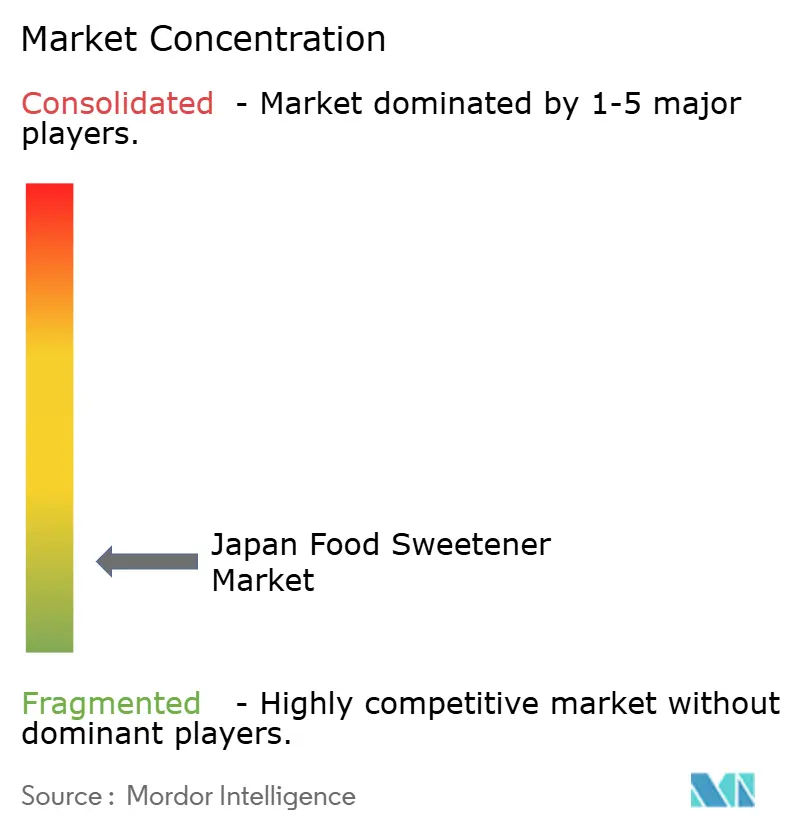
Recent Industry Developments
- April 2025: Tate & Lyle announced a strategic partnership with Manus Bio through the Natural Sweetener Alliance to commercialize stevia Reb M production using precision fermentation technology.
- June 2024: Morita Kagaku Kogyo introduced a next-gen line of stevia-based sweeteners, prominently featuring Rebaudioside M (Reb M) alongside other steviol glycosides. This new sweetener range emphasizes a high-purity Reb M profile, celebrated for its clean, sugar-like flavor with minimal bitterness. This characteristic makes it particularly suitable for applications demanding high sweetness intensity without undesirable aftertastes.
- June 2024: Saraya Japanese Middle East for Industrial Investment officially inaugurated a new $12 million factory complex in the Sokhna Integrated Zone within the Suez Canal Economic Zone (SCZone). The facility spans 20,000 square meters across two phases and hosts four production lines producing sterilization products, natural cosmetics, packaging of the natural sugar-free sweetener “Lakanto,” and jojoba oil extraction destined for export to cosmetics companies in Europe and Asia.
- May 2024: JK Sucralose Inc. initiated its sucralose technical transformation project in the Economic Development Zone of Sheyang Port, located by the Yellow Sea. With an annual production capacity set at 4,000 tons, the project boasts an investment surpassing CNY 1 billion. Spanning an additional 390,000 square meters, the site allocates nearly 100,000 square meters for new production facilities and essential infrastructure. Once fully operational, the project anticipates an impressive output value of CNY 2 billion.
Japan Food Sweetener Market Report Scope
Sweeteners are food additives that impart a sweet taste to food and beverage products.
The food sweetener market in Japan is segmented by type and application. Based on the type, the market is segmented into sucrose, starch sweeteners and sugar alcohols, and high-intensity sweeteners (HIS). Starch sweeteners and sugar alcohols are further sub-segmented into dextrose, high fructose corn syrup (HFCS), maltodextrin, sorbitol, xylitol, and other starch sweeteners and sugar alcohols. The high-intensity sweeteners (HIS) are further sub-segmented into sucralose, aspartame, saccharin, neotame, stevia, cyclamate, acesulfame potassium (Ace-K), and other applications. Based on the application, the market is segmented into bakery and confectionery, dairy and desserts, beverages, meat and meat products, soups, sauces and dressings, and other applications.
For each segment, market sizing and forecast have been done based on value (USD).
| Sucrose | |
| Starch Sweeteners & Sugar Alcohols | Dextrose |
| High-Fructose Corn Syrup (HFCS) | |
| Maltodextrin | |
| Sorbitol | |
| Xylitol | |
| Other Starch Sweeteners & Sugar Alcohols | |
| High-Intensity Sweeteners (HIS) | Sucralose |
| Aspartame | |
| Saccharin | |
| Cyclamate | |
| Ace-K | |
| Neotame | |
| Stevia | |
| Other High-Intensity Sweeteners |
| Bakery Products |
| Confectionery Products |
| Dairy and Desserts |
| Sauces Dressings and Spreads |
| Beverages |
| Other Applications |
| Product Type | Sucrose | |
| Starch Sweeteners & Sugar Alcohols | Dextrose | |
| High-Fructose Corn Syrup (HFCS) | ||
| Maltodextrin | ||
| Sorbitol | ||
| Xylitol | ||
| Other Starch Sweeteners & Sugar Alcohols | ||
| High-Intensity Sweeteners (HIS) | Sucralose | |
| Aspartame | ||
| Saccharin | ||
| Cyclamate | ||
| Ace-K | ||
| Neotame | ||
| Stevia | ||
| Other High-Intensity Sweeteners | ||
| Application | Bakery Products | |
| Confectionery Products | ||
| Dairy and Desserts | ||
| Sauces Dressings and Spreads | ||
| Beverages | ||
| Other Applications | ||
Key Questions Answered in the Report
What is the projected value of the Japan food sweeteners market in 2030?
The market is forecast to reach USD 9.02 billion by 2030.
Which product category is expanding the fastest?
High-intensity sweeteners are projected to grow at a 5.42% CAGR through 2030.
How large is the beverage segment within the market?
Beverages accounted for 38.58% of total market value in 2024, the largest among all applications.
Why are plant-based sweeteners gaining traction?
Regulatory support and consumer demand for clean-label products propel plant-based options, which are growing at a 4.62% CAGR.
